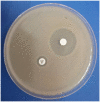Ceftriaxone- and ceftazidime-resistant Klebsiella species, Escherichia coli, and methicillin-resistant Staphylococcus aureus dominate caesarean surgical site infections at Mulago Hospital, Kampala, Uganda
- PMID: 35154757
- PMCID: PMC8826261
- DOI: 10.1177/2050312120970719
Ceftriaxone- and ceftazidime-resistant Klebsiella species, Escherichia coli, and methicillin-resistant Staphylococcus aureus dominate caesarean surgical site infections at Mulago Hospital, Kampala, Uganda
Abstract
Objectives: The aim of this study was to determine the proportion and mechanism of resistance to ceftriaxone and ceftazidime among Klebsiella species and Escherichia coli and examine the burden of methicillin-resistant Staphylococcus aureus from caesarean section surgical site infections in Uganda.
Methods: Wound swabs from 109 caesarean section surgical site infections were cultured for pathogenic bacteria following standard microbiological procedures. The Kirby-Bauer disc diffusion technique was used for antimicrobial susceptibility testing. Methicillin-resistant S. aureus diagnosis was based on polymerase chain reaction testing for the mecA gene. Data were analysed using SPSS-IBM Statistics v.20.
Results: A total of 118 pathogens were recovered from 93 (85%) of 109 surgical site infections swabs. Of the 118 pathogens, gram-negative bacteria were 69 (58.5%), including 44 (37.3%) Klebsiella species, 11 (9.3%) E. coli, 6 (5.1%) Citrobacter species, and 8 (6.8%) other gram-negative bacteria. In total, 49 of the 118 pathogens were gram-positive bacteria, including 34 (28.8%) S. aureus and 15 (12.7%) Enterococci species. Resistance to ceftriaxone was detected in all 11 (100%) of the E. coli and in 43 (97.7%) of the 44 Klebsiella species and to ceftazidime in all 11 (100%) of the E. coli and 40 (91%) of the 44 Klebsiella species. Extended-spectrum beta-lactamase explained resistance to ceftazidime in 10 (91%) of the 11 E. coli and 19 (48%) of the 40 Klebsiella species. Carbapenemase production explained 15 (38%) of the 40 ceftazidime-resistant Klebsiella species. Methicillin-resistant S. aureus was detected in 91% of S. aureus.
Conclusion: Klebsiella species, E. coli, and S. aureus-majority methicillin-resistant S. aureus dominated the pathogens in caesarean section surgical site infections. Almost all of the E. coli and Klebsiella species were resistant to ceftriaxone or ceftazidime. Extended-spectrum beta-lactamase was the underlying resistance mechanism among almost all of the ceftriaxone- or ceftazidime-resistant E. coli. However, this mechanism accounted for less than half of ceftriaxone- or ceftazidime-resistant Klebsiella species, where carbapenemases accounted for 40% of the resistance, a finding previously unreported in Uganda.
Keywords: Caesarean section; extended-spectrum beta-lactamase; methicillin-resistant Staphylococcus aureus (MRSA); surgical site infections.
© The Author(s) 2020.
Conflict of interest statement
Declaration of conflicting interests: The author(s) declared no potential conflicts of interest with respect to the research, authorship, and/or publication of this article.
Figures



Similar articles
-
Prevalence of methicillin resistant Staphylococcus aureus, multidrug resistant and extended spectrum β-lactamase producing gram negative bacilli causing wound infections at a tertiary care hospital of Nepal.Antimicrob Resist Infect Control. 2018 Oct 8;7:121. doi: 10.1186/s13756-018-0408-z. eCollection 2018. Antimicrob Resist Infect Control. 2018. PMID: 30338059 Free PMC article.
-
Laboratory confirmed puerperal sepsis in a national referral hospital in Tanzania: etiological agents and their susceptibility to commonly prescribed antibiotics.BMC Infect Dis. 2019 Aug 5;19(1):690. doi: 10.1186/s12879-019-4324-5. BMC Infect Dis. 2019. PMID: 31382913 Free PMC article.
-
[Analysis of pathogen spectrum and antimicrobial resistance of pathogens associated with hospital-acquired infections collected from 11 teaching hospitals in 2018].Zhonghua Yi Xue Za Zhi. 2020 Dec 22;100(47):3775-3783. doi: 10.3760/cma.j.cn112137-20200430-01389. Zhonghua Yi Xue Za Zhi. 2020. PMID: 33379842 Chinese.
-
Literature review on the distribution characteristics and antimicrobial resistance of bacterial pathogens in neonatal sepsis.J Matern Fetal Neonatal Med. 2022 Mar;35(5):861-870. doi: 10.1080/14767058.2020.1732342. Epub 2020 Feb 26. J Matern Fetal Neonatal Med. 2022. PMID: 32102584 Review.
-
Ceftobiprole: a review of a broad-spectrum and anti-MRSA cephalosporin.Am J Clin Dermatol. 2008;9(4):245-54. doi: 10.2165/00128071-200809040-00004. Am J Clin Dermatol. 2008. PMID: 18572975 Review.
Cited by
-
Achyranthes aspera Extracts as Adjuvants for the Redressal of Antibiotic Resistance.Pharmaceutics. 2022 Oct 18;14(10):2219. doi: 10.3390/pharmaceutics14102219. Pharmaceutics. 2022. PMID: 36297652 Free PMC article.
-
The Importance of Carbapenemase-Producing Enterobacterales in African Countries: Evolution and Current Burden.Antibiotics (Basel). 2024 Mar 24;13(4):295. doi: 10.3390/antibiotics13040295. Antibiotics (Basel). 2024. PMID: 38666971 Free PMC article. Review.
-
Development of a local antibiogram for a teaching hospital in Ghana.JAC Antimicrob Resist. 2023 Mar 27;5(2):dlad024. doi: 10.1093/jacamr/dlad024. eCollection 2023 Apr. JAC Antimicrob Resist. 2023. PMID: 36994232 Free PMC article.
-
Increasing Antimicrobial Resistance in Surgical Wards at Mulago National Referral Hospital, Uganda, from 2014 to 2018-Cause for Concern?Trop Med Infect Dis. 2021 May 19;6(2):82. doi: 10.3390/tropicalmed6020082. Trop Med Infect Dis. 2021. PMID: 34069345 Free PMC article.
-
Antibiotic resistance of E. coli isolates from different water sources in Mbarara, Uganda.J Water Health. 2024 Sep;22(9):1579-1593. doi: 10.2166/wh.2024.319. Epub 2024 Aug 22. J Water Health. 2024. PMID: 39340372
References
-
- Horan Teresa CG, Robert P, Martone WJ, et al.. CDC definitions of nosocomial surgical site infections, 1992: a modification of CDC definitions of surgical wound infections. Infect Control Hospital Epidemiol 1992; 13(10): 606–608. - PubMed
LinkOut - more resources
Full Text Sources
Molecular Biology Databases

